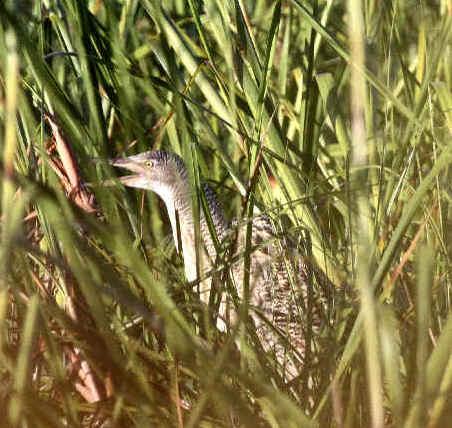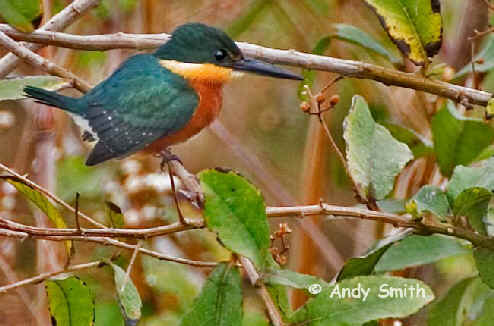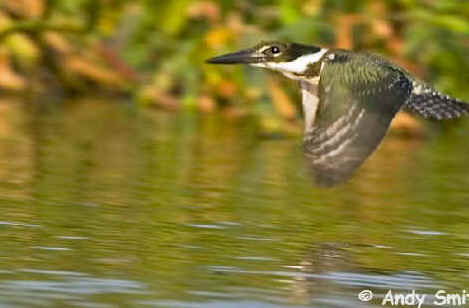
E-mail: font@focusonnature.com
Phone: Toll-free in USA 1-800-721-9986
or 302/529-1876
 |
PO Box 9021,
Wilmington, DE 19809, USA E-mail: font@focusonnature.com Phone: Toll-free in USA 1-800-721-9986 or 302/529-1876 |
THE FOCUS ON NATURE TOUR IN GUATEMALA
March 2006

The Pinnated Bittern during
this tour,
in a marsh along the Pacific coast,
was a wonderful find.
Links:
List of Birds during our Guatemala Tour - March '06
A Cumulative List of Birds during FONT tours in Guatemala
Upcoming FONT Birding & Nature Tours in Guatemala
The following account written by Armas Hill, leader
of the tours:
During our
March 7-19, 2006, birding & nature tour in the highlands
& lowlands of Guatemala, 326
species of birds were seen.
One of the most interesting aspects of the tour was how many of those bird
species were seen from boats. In all, we did a record-setting 6 boat-trips
during the tour.
Notable among them were those we took in an area of mangroves and marshes along
the Pacific coast. During one of those trips, on a small boat without a motor,
going from the mangroves to the marsh early in the morning, we were treated to
quite a surprise, a Pinnated Bittern, by reeds at the water's edge. At
first, from a distance, we expected the bird to be an immature Bare-throated
Tiger-Heron. But it was not, as we could see when we got closer to it, as,
in its frozen posture, it pointed it bill toward the sky.
The Pinnated Bittern was unexpected as, according to Steve Howell's
"Guide to the Birds of Mexico and Northern Central America", there had
only been 1 previous Guatemalan record, and that was on the Caribbean side of
the country. There is a population in northern Belize and the Yucatan Peninsula
of Mexico, isolated from where the species mostly occurs, in South America.
That bird was actually just one of the nice ones we saw that beautiful morning
in the Guatemalan marsh. We had just seen, in the mangroves, Boat-billed
Herons (always nice to see), and an attractive adult Gray-headed
Kite flying by close to us at eye-level. The morning sunlight and being on
the small silent boat, paddled by our young boatman, added to the sightings.
We went initially on the boat into the marsh hoping to see a Jabiru, a huge
stork that's rare in Guatemala. We didn't, so went back, in the afternoon,
further into the marsh, on a slightly larger boat with a motor. There were
thousands of birds. Among them, there were a few hundred American White
Pelicans and Wood Storks. These were in addition to many egrets
and herons, thousands. Lesser Yellow-headed Vultures were common,
gliding in their distinctive way low over the marsh. The groups of large
White Pelicans and Wood Storks drifted higher into the clear sky.
There was no Jabiru among them, but that was fine. Going there, looking for it,
got us to a place where it was wonderful to be.
In all, we were to take 3 boat-trips in that "birdy" area. The last
was on a small ferry (only large enough to hold our vehicle), winding its
way in channels, going from the town on the barrier coastal island where we had
stayed a couple days and nights, and toward the mainland. We continued to look
in the sky for the Jabiru.
Birds that we had seen in the large area of mangrove and marsh, however, in
addition to the already-mentioned Pinnated Bittern, Boat-billed Herons, White
Pelicans, Wood Storks, Lesser Yellow-headed Vultures, and Gray-headed
Kite, included these:
Least Grebe, Brown Pelican, Anhinga, Great Blue Heron, Little Blue Heron,
Tricolored Heron, Great Egret, Snowy Egret, Green Herons (more than could
be imagined), Black-crowned Night-Heron and Bare-throated
Tiger-Heron, White Ibis, Blue-winged Teal, Osprey, Mangrove Black Hawk,
Moorhens, Purple Gallinules, Northern Jacanas, Spotted Sandpipers, Laughing
Gull, an assortment of Terns including Caspian and Gull-billed,
White-fronted and Yellow-naped Parrots, Violaceous Trogon, Great
Kiskadee, Mangrove Swallow, Mangrove Vireo, Prothonotary Warbler, Northern
Waterthrush, and White-collared Seedeaters.
Those boat-rides were certainly worth doing!
We did another, on the other side of the country, in a remote region of part of
Guatemala called the Peten. It was along a
river, called the Rio de la Pasion. We've
traveled by boat along that river a number of times during our previous tours in
Guatemala. We've seen many birds there in the past, but during our March '06
tour, we saw there for the first time, on a mudbank along the river's edge, an Agami
Heron. It was slowly stalking, with its long bill ready to make a catch.
We spent a night at a lodge by that river, about 3 hours from where our
boat-ride began, so we had a second trip by boat the next day as we traveled
back.
Birds that we saw along the Rio de la Pasion, in addition to the Agami,
included:
Neotropic Cormorant, Anhinga, Great Blue and Little Blue Herons, Great
and Snowy Egrets, Green Heron, Boat-billed Heron, Plumbeous Kite,
Short-tailed Hawk, Bat Falcon, Limpkin, Gray-necked Wood-Rail (many),
Sungrebe, Spotted Sandpiper, Aztec Parakeet, Short-tailed Nighthawk, and
all 5 of the species of Kingfishers that occur in Guatemala: Ringed,
Belted, Amazon, Green, and American Pygmy.
Again, these were boat-rides worth doing!
To look for a species that we did not encounter along the Rio de la Pasion, we
took yet another boat-trip in the Peten region. It was in a small boat along
little rivers that flowed into a big lake known as Lago
de Peten Itza. It was the first time that we did such a boat-ride,
and it enabled us to find the bird we were aiming for, the Ruddy Crake.
Those two small rivers were each with clear water filled with small fish. First,
in the morning mist, and then in the early day's sunlight, it was for us yet
another wonderful experience. Along the edges of the small rivers, in addition
to the crake in the grass, there were, in the foliage, jacanas and gallinules.
In the nearby trees, that morning, the passerine birds were active. Among those
that were colorful were Orioles including Black-cowled and Yellow-tailed.
Of course, a premier place to visit in the Peten region for birding, and for its
own right, is Tikal. In a national park,
it's the site of a Mayan city that flourished over a thousand years ago. Among
the structures of the place that remain, and in the nearby forest, Neotropical
birding is superb.
Again, in March '06, as during previous FONT tours, we saw an Orange-breasted
Falcon by one of the Tikal temples. Seeing that bird, even though we
have during 5 recent tours, is not something to be taken for granted. The
species has a wide range in the American tropics but it not readily seen at many
places.
We had another sighting at Tikal that was quite special, when we saw a
Pheasant Cuckoo near us, on the ground, doing a display, with its wing, and
making a buzz. We've seen and heard that display before, but, as always, it was
good to see it again.
Years ago, there was a runway at Tikal for small planes. Now, it's been
overtaken by foliage, brush and trees that continue to grow. But the middle of
the runway is still a trail that can be walked and should be birded. We did, in
the morning, and late in the day. At dusk, it was great there to see and hear
the Yucatan Poorwills and Pauraques as they flew about and called.
The Guatemalan, or Vermiculated, Screech-Owl also called in the
background, as did a pair of Laughing Falcons dueting at the day's end -
a day during which we had seen the fine assortment of Tikal birds, such as toucans,
parrots, trogons, oropendolas, aracaris, antbirds, manakins, woodcreepers,
flycatchers, tanagers, and warblers. Among the last of these we saw
some that spend their non-breeding months at Tikal, and, when there, they are
especially nice to see in numbers. These Warblers included Hooded,
Kentucky, Worm-eating, Blue-winged, Golden-winged, and Magnolia.
A number of the birds at Tikal are larger than warblers. Obvious among them are
the colorful Ocellated Turkeys that walk about, as well as Great
Curassows, Crested Guans, and Plain Chachalacas.
In the forest at Tikal, it was fun to find mixed flocks as they moved about. In
them, there were birds such as the Black-throated Shrike-Tanager and the Royal
Flycatcher. There were others too, of course. Buntings included the Painted,
that visits the area, and the bright Blue Bunting that stays. And there
was a warbler, not yet mentioned, that also stays. Its the Gray-throated Chat,
and we saw it well.
In the Guatemalan mountains, where the
Mayans of today live, there's another cast of Warblers. Again, some come
from North America where they nest. Those in that group that we saw included: Townsend's,
Black-throated Green, Hermit, Nashville and Tennessee, and the Red-faced.
These were in addition to the those that are resident. The "top
attraction" among them is the Pink-headed Warbler, but there's also
the Crescent-chested, the Golden-browed and the Rufous-capped,
and the Slate-throated Redstart.
Other birds that we saw in the Guatemalan highlands included the Rufous-collared
Robin, the Blue-and-white Mockingbird, the Elegant (or Blue-hooded)
Euphonia, the Gray Silky-Flycatcher, Brown-backed Solitaire,
and the Hooded Grosbeak.
And, of course, there were the hummingbirds. In Guatemala, there are some
nice ones to be seen. Those we saw included: the Rufous Sabrewing (a
large one), the Emerald-chinned (a tiny one), the Sparkling-tailed
Woodstar, and the White-eared, Berylline, Azure-crowned, and Blue-tailed,
just to name a few of the 20 species of hummingbirds we saw during the tour.
And with, that we've mentioned a few of the birds that we saw during our March
2006 tour in Guatemala. But still there were others that were notable, such as
the Scissor-tailed and Fork-tailed Flycatchers, the Gray-collared
and the Rose-throated Becards, and the many orioles, including
the Spot-breasted, Altamira, and Black-vented, in addition to the Baltimore
and Orchards that were so common. And certainly added to the mix would be
the Blue-crowned Motmot, Rufous-tailed Jacamar, and White-whiskered
Puffbird, as each of these is always a pleasure to see.
And there was the Pale-billed Woodpecker and the Ivory-billed
Woodcreeper (yes, that nomenclature is right, although the Pale-billed
Woodpecker is related to the "infamous one").
Also, during the tour, along with the birds, there were the places that were
great to visit, both in the highlands and the lowlands, including, as mentioned,
Tikal, and the rivers and marshes through which we took the boat-rides. We end
this narrative, now, however, in a truly wonderful forest that we visited on the
Pacific Slope. As we walked the trails
through the green woods in the afternoon, we were surrounded with the sounds of
the calling manakins. The bird, nice to hear, was also nice to see.
It was the beautiful red, black, and bright blue Long-tailed Manakin. As
they called, they displayed. We watched them perform that afternoon, and their
antics were among the many avian acts during our March 2006 Guatemala Tour that
we would nicely remember.

Two of the
five species of kingfishers that we saw
during a boat-ride along a river
during our March '06 Guatemala Tour.
The Pygmy Kingfisher (above)
and the Green Kingfisher (below).
